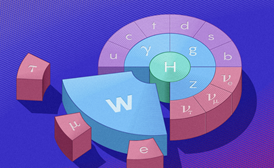Mass of W boson puts Question over Standard Model
- 11 May 2022
A new measurement of a fundamental particle called the W boson appears to defy the Standard Model of particle physics, our current understanding of how the basic building blocks of the universe interact.
- The scientists at the Fermilab Collider Detector (CDF) in Illinois, USA have found that elusive W boson has a slightly (1%) higher mass (80,433,000 electron volts) than predicted in the Standard Model (80,357,000 electron volts). The difference is tiny but in the world of particle physics, it is huge anomaly. This means that the Standard Model may be in for a massive overhaul.

(Image Source: quantamagazine.org)
Standard Model
- The Standard Model of particle physics is a theory that attempts to classify all the subatomic particles in the world — basically the building blocks of matter — as well as the interactions between them.
- There are basically two main classes of fundamental particles per the Standard Model. There are fermions like electrons, protons, neutrons, and other leptons and quarks. These are the stuff that regular matter is made of. Then there are bosons, photons, and gluons — the so-called force carriers because they don’t make up stuff but rather transmit forces.
- The Standard Model describes three of the four fundamental interactions – Electromagnetism, Strong Nuclear Force, and Weak Nuclear Force. Only gravity remains unexplained.
- Particles called bosons serve as mediators for these forces between particles of matter. The weak force, which is responsible for radioactive decay, uses the W boson as one of its messengers.
Questions over Standard Model
- The Standard Model is often questioned as - it has no explanation for gravity, dark matter and the absence of antimatter in our universe. So physicists are constantly on the lookout for deviant measurements that could lead to new theories.
About W boson
- Discovered in 1983, the W boson is a fundamental particle. Together with the Z boson, it is responsible for the weak force, one of four fundamental forces that govern the behaviour of matter in our universe. Particles of matter interact by exchanging these bosons, but only over short distances.
- The W boson, which is electrically charged, changes the very make up of particles. It switches protons into neutrons, and vice versa, through the weak force, triggering nuclear fusion and letting stars burn. This burning also creates heavier elements and, when a star dies, those elements are tossed into space as the building blocks for planets and even people.




